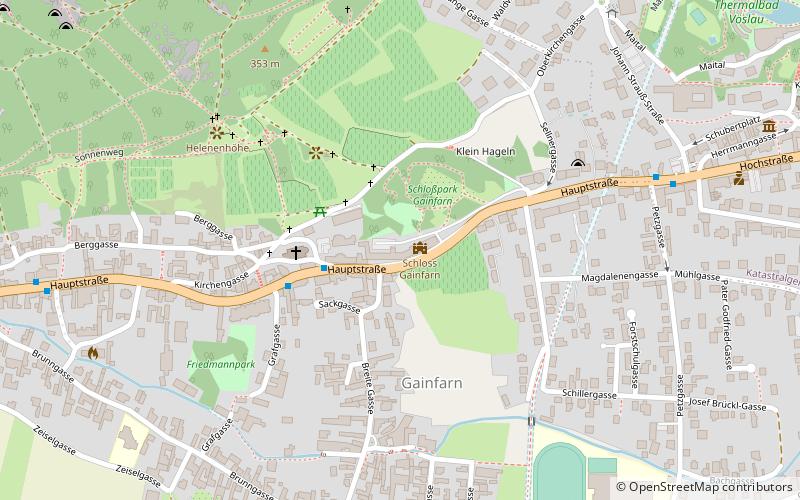Schloss Gainfarn, Bad Vöslau


Facts and practical information
Gainfarn Castle is a castle in the cadastral municipality of Gainfarn in Bad Vöslau. The castle, which today houses the music school of Bad Vöslau, has a very similar development and ownership history as Merkenstein Castle, which is located in the neighboring village of Großau, as the estates of Gainfarn and Großau belonged together for a long time.
A Rudwinus von Gainfarn was already mentioned in 1206 in the Salbuch of the monastery Klosterneuburg. However, the location of his seat, the so-called Feste Haus, is not known. The Hohenbergs, who owned the Gainfarn estate, moved their seat to Merkenstein Castle as early as 1448. In any case, the castle that still exists today is much younger.
When Merkenstein Castle was destroyed in the course of the Second Turkish Siege, the seat of the lordship was again transferred to Gainfarn. Both the village and the castle of Gainfarn were in the possession of the Dietrichsteins from 1675, i.e. also during the Turkish siege, until 1829. Even before the change of ownership, the castle underwent reconstruction to its present appearance by Joseph Carl von Dietrichstein, the first governor of the Privilegirten Oesterreichischen National-Bank. In 1816 he had the main wing rebuilt into its classicist form.
In 1829 Joachim Eduard Count Münch-Bellinghausen acquired the two estates Gainfarn and Großau with Merkenstein. After his death, Adolph Freiherr von Brenner-Felsach also inherited this castle in 1866. He, in turn, bequeathed it to his son Joachim von Brenner-Felsach, who became famous for his world travels and the photographs taken during them, which are exhibited in today's Museum für Völkerkunde in Vienna. From 1897 to 1901, Hugo von Hofmannsthal was a frequent guest at the castle.
In 1911 Brenner-Felsach sold the castle with its possessions to the sawmill owner Leopold Kern, who owned it until 1917. The industrialist Arthur Krupp from Berndorf bought it from him at the same time as the Merkenstein estate. He made it available as a military hospital in the last year of the First World War.
After the Second World War, when all the property of the Krupp family was confiscated by the Soviet occupation forces as German property, Gainfarn Castle and Estate also fell under the administration of USIA. During this time the castle deteriorated visibly. After the State Treaty, the property fell to the Republic of Austria and thus to the Federal Forests. In addition to the already existing forestry schools in Bruck an der Mur and Gmunden, the Federal Forests established a forestry school in Waidhofen an der Ybbs and now in Gainfarn in 1948. With the reorganization of the entire Austrian school system, a higher department with a Matura degree for forester training was established in 1972. An institute for bee science was also rented for a time.
However, at the turn of the millennium this school was closed. Most of the forest property of 5,000 ha was sold earlier.
In 2001, the municipality of Bad Vöslau acquired the castle. The renovated and adapted castle has since housed the Bad Vöslau Music School.
Breitegasse 12Bad Vöslau
Schloss Gainfarn – popular in the area (distance from the attraction)
Nearby attractions include: Römertherme Baden, Rauheneck Castle, Strandbad Baden, Arnulf Rainer Museum.











